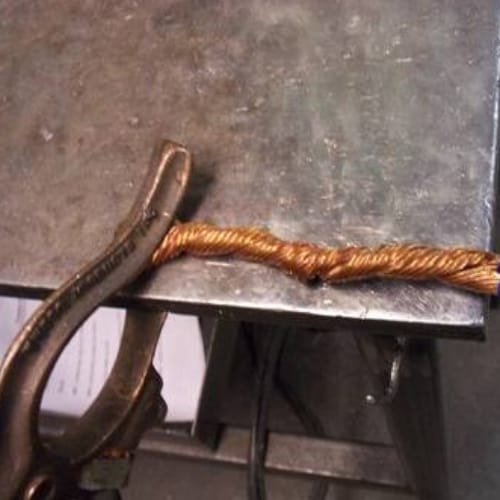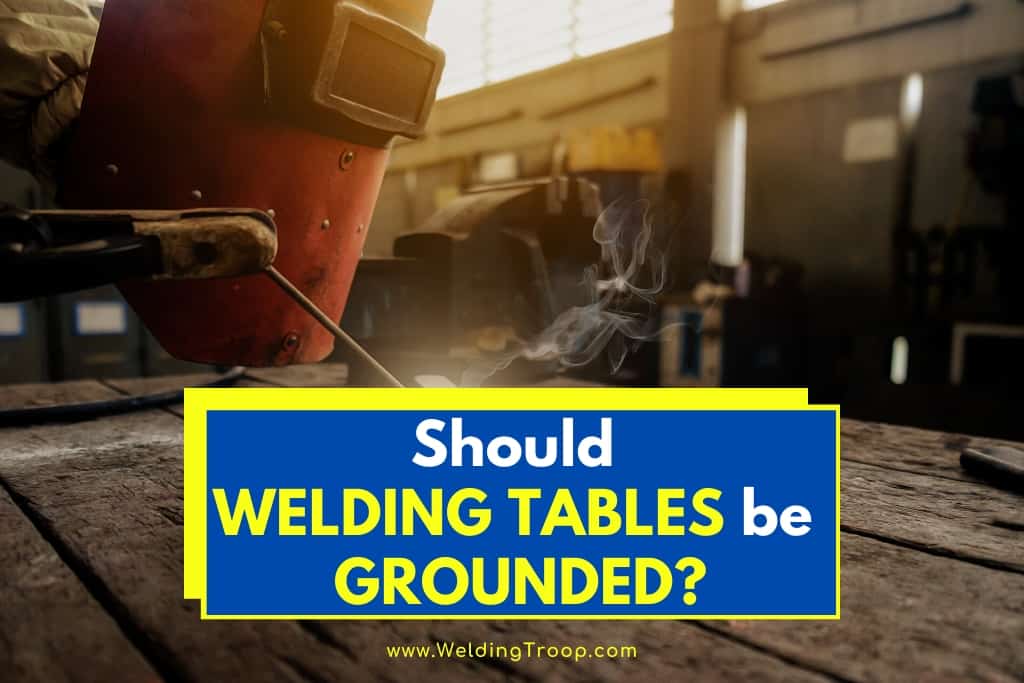Grounding is an integral part of welding or doing any kind of craft that involves significant amounts of high voltage electricity. Arc welding is an art that can bond various kinds of exotic metals, but the electricity involved means that safety precautions need to be taken.
So, should welding tables be grounded? Yes, welding tables should be grounded to prevent voltage leakage from the output leads. Whenever working with high voltage electricity, grounds prevent electricity from arcing and finding a human target. Welders are unlikely to be electrocuted without a ground, but they can receive a nasty shock.
Knowing how to protect yourself when using a welding machine is the most important thing you learn before you ever pick up a piece of filler metal. Read on to find out more about why grounding tables is essential and how to do it.
Table of Contents
Should Welding Tables be Grounded?
The consequences of not grounding a welding table are dependent on the type of welding being done.
Grounding isn’t just done to prevent electrical shock. It’s also performed to prevent high-frequency signals from radiating away from the welding area and interfering with nearby electrical devices such as televisions and radios.
Aside from electrical interference, high voltage stray welding currents are capable of causing workspace fires or shocking and electrocuting the welder or bystanders. Because of this, the American National Standards Institute (ANSI) stipulates in their standard operating procedure Z49.1 (“Safety in Welding, Cutting, and Allied Processes”) that the workpiece or a welding table must be grounded separately from the welding circuit.

In many cases, a welder is likely to get lucky even if their table isn’t properly grounded, and there will be no damage done.
But the risk of electrical shock, electrocution, or an electrical fire isn’t worth the risk of skipping a table ground.
Learn More About Welding Safety – Here, you can find an article from our website about: Personal Protective Equipment for Welders – PPE | List, and Requirements
How Does A Welding Ground Work?
The ground in a welding table is an electrical return path—the leads on your welding machine don’t have any path to the supply ground. There are several charged wires in single-phase A/C wiring: one or two hot (live) wires, plus a neutral and ground that both share a connection at the main
service panel.
A welding circuit can work without a ground. The ground is only included in the circuit for safety purposes. A/C circuits can operate with either two hot leads or a hot lead and a neutral lead.
A ground consists of any material which is driven into the ground that can efficiently conduct electricity, but grounding a welding table specifically deters stray voltage caused by welding operations to jump to any nearby electrical equipment or people.
What Happens If You Don’t Ground a Welding Table?
The main risk of not grounding your work while welding is that arc welding involves using an open circuit of electricity to weld and stray voltage from the welder may end up being conducted into the welder if the welder’s body is the path of least electrical resistance.
Since the voltages involved in welding are relatively low, a welder is unlikely to be electrocuted (or killed by electricity) when zapped by stray voltage from a welding machine. However, the shock can be surprising and painful and can damage the welding machine, the work in progress, or nearby equipment if the welding torch is dropped.
In arc welding, a ground clamp is necessary because the arc from the electrode is caused by the TIG torch trying to establish a circuit with the table. In this case, the grounding lead is known as the work lead. Without it, the weld can’t happen because the torch won’t arc.
Is It Possible to Weld Without Grounding the Welding Table?
The short answer is yes; there are plenty of welders who weld without grounding their welding table, instead opting to attach a work lead as close to the piece being welded as possible. The main reasoning behind not grounding the welding table is that the resulting electrical resistance can sometimes lead to overheating damage and the threat of a fire hazard depending on the voltage used.
However, welding without grounding can lead to radiofrequency malfunctions in surrounding electronic equipment, so depending on the workshop environment, not grounding the welding table can lead to ambient environmental damage.
The main risk involved in grounding the welding table is that welding involves a variety of polarities, voltages, and frequencies, as connecting these transient spikes to a building’s electrical system can cause shortages and other electrical problems.
How Do You Ground a Welding Table?
Welding tables are grounded by including a ground clamp in their welding circuit. Many welding tables come with a grounding clamp included already, but if you are building a welding table, it is a good idea to include a clamp to ground the table.
This is the basic method for grounding a welding table:
- A grounding weld can be attached at two places—either the metal welding workbench itself or the work that is being welded on. Attaching the welding clamp flush to the underside of a workbench will keep it from getting in the way during a weld.
- Attaching the grounding clamp to the workbench in an unobstructed place efficiently grounds the weld, but also makes the table itself a part of the circuit, leaving the welder open to ambient shocks when they touch the table. To avoid this, a grounding clamp can be attached to the piece of welding work itself.
- If there is no easy place on the welding work itself to attach the grounding clamp due to the size or shape of the piece, a larger vise-grip welding clamp can be attached that to the piece first, then attach the grounding clamp to the larger clamp.
To learn how to weld your grounding table and more about welding grounds and electrical safety, here is an instructional video that may help.
How To Improve A Cheap Ground Clamp >> Check out the video below
The welding experts above demonstrate that there are several methods you can use to improve the efficiency of your grounding clamp to make your welding table both easier to operate and safer to use. Knowing how to ground your welding work properly is a vital part of operating in a workshop safely.
The more you know about how the electrical aspects of your equipment work, the more proficient you can become as a welder.
What is a Ground Clamp Used for in Welding?
A ground clamp is a clamp on the welding table used to connect the grounding wire to the workpiece to stabilize the weld and prevent stray electrical voltage. A ground can either be connected to the piece of metal that the welder is working on, or the welding table itself.
Since ground clamps are part of the welding circuit, they must be able to conduct electricity and capable of withstanding an electrical current without overheating because of electrical resistance. When choosing a type of grounding cable to be used with the ground clamp, the welder should consider the maximum amperage of welding current that is going to be conducted.
Here are some of the available grounding clamps and their maximum amperages:
| Ground Clamps | Maximum Amperage |
| Tweco 9205-1120 GC-200 Welding Ground Clamp | 200 amps |
| US Forge Welding Heavy Duty Bronze Grounding Clamp | 300 amps |
| KINGQ Welding Ground Clamp | 300 amps |
| LINCOLN ELECTRIC CO KH525 300A Ground Work Clamp | 300 amps |
| Hobart 770031 400-Amp T-Style Ground Clamp Brass | 400 amps |
| Gimiton 800 Amp Arc Welding Ground Clamp | 800 amps |
Welding and Electrical Safety
Along with making sure that the welding table is grounded correctly, there are other steps you can take while welding to ensure that all operators remain safe, and the welding job can be performed with minimal risk. Here are some of the safety rules you should observe while welding at a welding table:
- Make sure all associated cables are in good condition; remove and replace any cables that are shown to have fraying or other defects.
- Do not perform welding operations in wet conditions.
- Make sure all welding operations are performed with welding gloves to prevent direct skin-to-current contacts.
- Use rubber boots and an insulating pad in the welding area.
Taking just a few minor precautions in the workshop can help prevent an electrical accident while operating a welding machine.
Grounding Your Welding Table Is an Important Part of Welding Safety
Besides allowing a TIG welder to work, having a ground clamp on your welding table allows you to ground your welding work and helps prevent electrical accidents.
While electrocution and electrical injury from welding rigs are relatively rare compared to the number of people who use them, it’s still crucial for welders to respect the power of electricity when operating a welding machine.
Sources:
esabna.com/euweb/awtc/lesson2_7.htm
telwin.com/en/telwin-academy/saldatura/mma-welding/
millerwelds.com/resources/article-library
ccohs.ca/oshanswers/safety_haz/welding/electric.html
Recommended Reading
Why do Welding Tables Have Holes? >> Tips and Tricks You Need To Know

